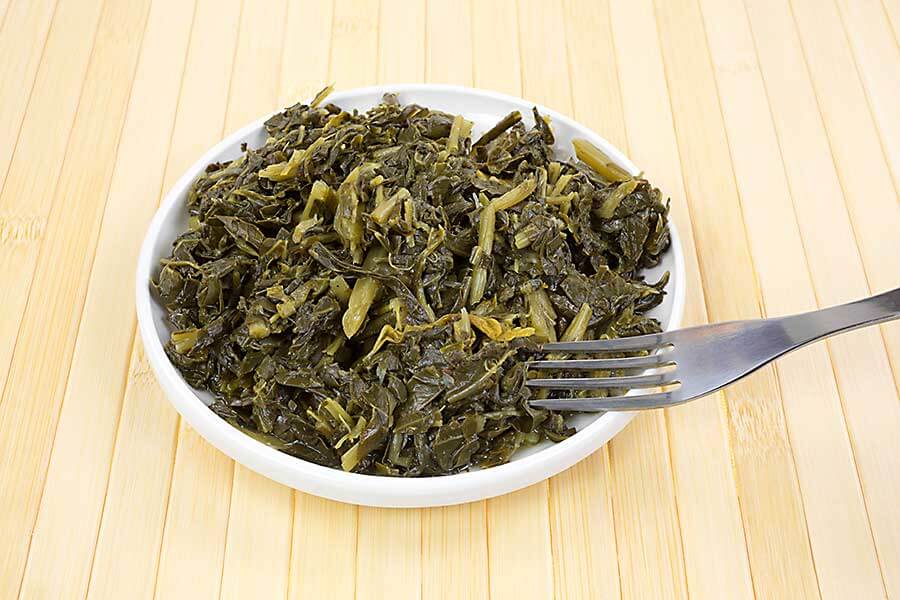Collard Greens
Collard greens refers to a variety of loose-leafed vegetables that come from the Brassica oleracea family, part of the Acephala species group. The vegetables are from the same group that includes cabbage, broccoli, kale, and spring greens. Evidence shows that collard greens have been consumed by humans for more than 2,000 years, having been cultivated by the Ancient Greeks.
The term ‘collard’ itself comes from the word colewart, meaning wild cabbage. However unlike cabbage, collard greens do not have a ‘head’ of a close-knit core of leaves. In fact, the term Acephala comes from the Greek phrase ‘without a head’, referring to this lack of core leaves. While linked with cabbage, collard greens are actually more closely aligned with kale.
Cultivating collard greens
Collard greens feature large, thick, dark green leaves that contain the edible portion of the vegetable, and are also grown as a garden ornamental. They can grow up to thirty centimetres tall and are quite sensitive to salinity in soil. The leaves of the plant must be picked before they reach full size or maturity. Collard green leaves are considered to be edible all year round, but it is more preferable to pick them during the cooler months. It is said that the taste is more preferable when picked after the first frost. Fresh leaves from younger plants are cooked differently from mature leaves as their texture differs. The vegetable is grown mainly in Brazil, Portugal, the southern states of the USA, as well as parts of Africa, the Balkans, Spain, and Kashmir in India.
Are collard greens healthy?
Collard greens are abundant in essential vitamins, minerals, as well as a high fibre content. They are an excellent source of vitamins A, B6, C, and K. The vegetable also contains protein, folate, thiamine, niacin, and dietary fibre – all of which are vital for living a healthy lifestyle. Collard greens are considered to be an excellent detoxing vegetable due to the presence of the sulphur-containing compound, glucosinolate. The compound is a natural liver cleanser.
The plant’s vitamin C content has antioxidant properties that help to fight damage caused from oxidation, while also inhibiting the growth of cancerous cells. Vitamin K and calcium help to strengthen bones and teeth, while dietary fibre aids digestion and enhances overall immunity. Collard greens also contain soluble fibre, which helps remove LDL cholesterol from the blood therefore reducing heart issues. Other benefits of the plant include encouraging hair growth, preventing anaemia and diabetes, and anti-ageing properties.
How to cook collard greens
Collard greens are featured in a number of different global cuisines.
- East Africa – Collard greens are known as sukuma wiki in East African countries such as Tanzania and Kenya. They are usually sautéed in oil, flavoured with onion and salt, and served as a side dish with meats. In Congo, Tanzania, and Kenya, collard greens also feature as the main accompaniment in a popular dish of maize cake.
- Southern USA – Collard greens are a staple in the cooking of the US southern states. They will often feature alongside other leafy greens such as mustard greens, turnip greens, spnach, and kale, served alongside smoked or salted meats. They are also traditionally consumed on New Year’s Day alongside black eyed peas and cornbread. Collard sauerkraut is another feature in southern US cuisine, often cooked with flat dumplings.
- Zimbabwe – Collard greens thrive in the climate of Zimbabwe and will feature in the garden of many homes. They are most commonly consumed with sadza, a type of polenta. Collard greens are also made into a stew with sautéed onions, tomato, and beef or pork.
- Brazil and Portugal – Collard greens are a popular accompaniment to meat and fish dishes, as well as feijoada, a pork and bean stew. In Portugal, collard greens are also the main ingredient of the classic soup caldo verde.
Private Chefs, Art of Dining
CHEFIN is a private chef platform that’s reimagining social dining.
You can easily connect with 1 of our 250 private chefs and treat your guests to restaurant-quality dining experiences in the comfort of your own home, office or chosen venue. From high-end dining to quirky social food experiences, the CHEFIN platform makes it effortless for you to access gourmet food that’s worthy of a Michelin-starred establishment.
What you get:
-
- Your very own private chef who is vetted and insured,
- A customised menu for your needs,
- 24/7 concierge support,
- Complete post-dinner cleanup,
- A fun, stress-free, and unforgettably dining experience!

